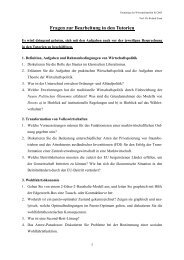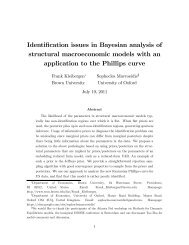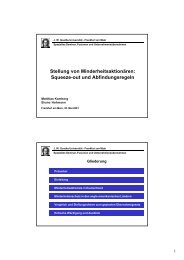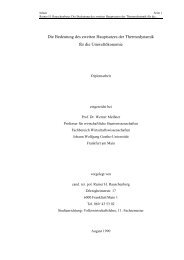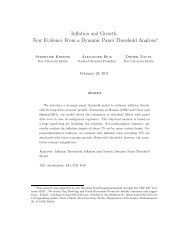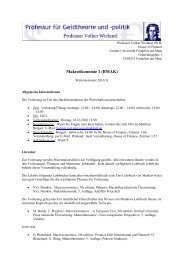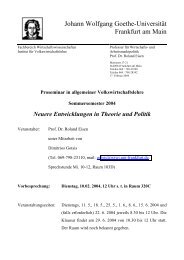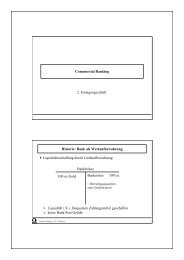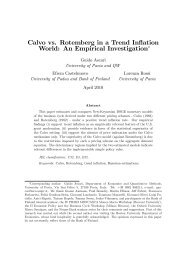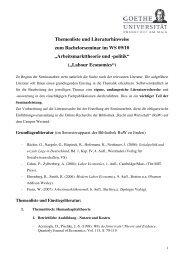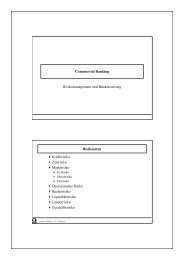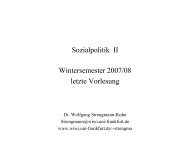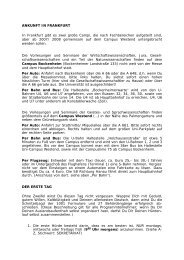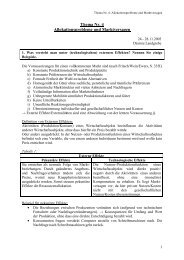Michael Burda - Sciences Po Spire
Michael Burda - Sciences Po Spire
Michael Burda - Sciences Po Spire
Create successful ePaper yourself
Turn your PDF publications into a flip-book with our unique Google optimized e-Paper software.
Blue Laws ∗<br />
<strong>Michael</strong> <strong>Burda</strong><br />
Humboldt-Universität zu Berlin and CEPR<br />
Philippe Weil<br />
Université Libre de Bruxelles, CEPR and NBER<br />
April 2004<br />
Abstract<br />
This paper investigates the economics of ”blue laws” or restrictions on<br />
shop-opening hours, most commonly imposed on Sunday trading. We<br />
show that in the presence of communal leisure or ”ruinous competition”<br />
externalities, retail regulations can have real effects in a simple<br />
general equilibrium model. We look for these effects in a panel of US<br />
states and in individual CPS data. An instrumental variable approach<br />
identifies the effects to the extent that blue laws are endogenous. We<br />
find that blue laws 1) reduce relative employment, 2) raise annual<br />
compensation and labor productivity, and 3) depress prices in the<br />
retail sector. The primary mechanism appears to be a reduction of<br />
part-time employment.<br />
Keywords: Blue laws, shop opening regulations, retail trade, employment<br />
JEL Classification: JEL Numbers: D62, J22, L81<br />
∗ Many people have heard this paper and it would be impossible to thank all who have<br />
contributed positively to its evolution, as did seminar participants at Berkeley, Irvine,<br />
Stockholm (IIES), FU Berlin, Frankfurt/Oder, CERGE (Prague), INSEAD, Rostock,<br />
Tilburg, WZ Berlin, Cologne, Göttingen, Dortmund, Rauischholzhausen, Freiburg, EUI<br />
Florence, Zurich, Mannheim, Bonn, Dresden, Aarhus, the Stockholm School of Economics<br />
and Koblenz. We are especially indebted to Katrin Kuhlmann for compiling the US blue<br />
law dataset used in the empirical analysis, and to Antje Mertens, Stefan Profit, Marco de<br />
la Negro and <strong>Michael</strong> Kvasnicka for help with data. Thanks are also due the Haas School<br />
of Business, UC Berkeley and to CES Munich for hosting both the authors at various<br />
stages of the project.<br />
1
1 Introduction<br />
Most cultural and religious traditions have holidays and weekly days of rest<br />
to allow for leisure, family activities, or scholarly contemplation. While it is<br />
easy to think of economic reasons why God might have commanded us to<br />
stop working from time to time, it is not clear why He commanded us all to<br />
rest at the same time. 1 Indeed, standard models generally tell us little about<br />
when leisure should be enjoyed. On the one hand, it is evidently desirable<br />
to coordinate leisure with our fellow humans; positive externalities can arise<br />
from resting or enjoying free time collectively. This external effect may apply<br />
to members of an immediate family as well as to a community or nation at<br />
large. At the same time, negative externalities may result from coordinated<br />
leisure or synchronized economic activity. Anyone who has visited Central<br />
Park or the Jardin du Luxembourg on a sunny weekend can appreciate this<br />
claim.<br />
The dilemma of coordination applies most acutely to retail trade and<br />
other consumer service sectors: almost by definition, these activities require<br />
some to work while while others do not. 2 While the desynchronization of<br />
retail hours and production schedules reduces congestion in stores, it does<br />
so at the cost of reduced coordination of leisure, posing elements of potential<br />
conflict in society. More generally, the recent acceleration of the trend<br />
towards a service economy necessarily implies that some must work while<br />
others consume or enjoy leisure.<br />
The coordination of leisure time as a public policy concern is the subject<br />
of the current paper. As a particular example, we investigate the theoretical<br />
rationale and empirical effects of so-called “blue laws“ or restrictions on<br />
shop opening hours, usually imposed on Sunday trading, but also on evening<br />
trading in a number of European countries. 3 Although these laws have been<br />
abolished in many US jurisdictions over the past three decades, they remain<br />
1 Similarly, it is difficult to explain the existence of the weekend, which unlike days,<br />
months and years, has no basis in solar or lunar cycles, yet evidently coordinates activity<br />
all over the world. For an exposition of the origins of the weekend, see Rybczynski (1991).<br />
2 In the case of retail, goods themselves can be stored and held at home while shops<br />
are closed; but the provision, marketing and sale of goods — the primary activities of the<br />
retail sector — cannot.<br />
3 According to Laband and Heinbuch (1987), the origin of the term “blue laws“ is<br />
ambiguous. According to one source, the first codification New Haven Colony’s laws<br />
appeared on blue-colored paper; another account links “blue“ to the strictness of devotion<br />
with which these laws were observed by North American Puritans.<br />
2
on the books of a number of states in some form. In Canada and many European<br />
countries, these regulations retain greater legal importance and are<br />
considered relevant for the policy debate concerning unemployment and job<br />
creation. The issue is also relevant in the United States, where discussion<br />
of whether “quality time“ is possible in two-earner families has once again<br />
surfaced. 4<br />
While the regulation of shop opening times may enjoy support of the public,<br />
it has costs in terms of productive efficiency: a store forced to close earlier<br />
suffers from excess capacity, since real capital assets (floor space, inventory,<br />
check out counters, cash) are not fully utilized. Opening-hour regulations are<br />
widely suspected of repressing the development, if not the absolute level, of<br />
output and employment in retail trade, banking and other personal service<br />
sectors. They may affect the labor force participation of females by restricting<br />
the availability of part-time jobs. These efficiency losses must therefore<br />
be balanced against the putative advantages of coordinated leisure and other<br />
public policy objectives.<br />
To evaluate these issues, we develop a simple general equilibrium model<br />
with an explicit retail sector in which consumers value ”communal” or social<br />
leisure (i.e., free time they spend with others) differently from solitary leisure.<br />
This introduces a shared leisure externality among economic agents which<br />
can serve as the rationale for the existence of blue laws. On the production<br />
side, we formalize the idea that blue laws might affect the technology of<br />
providing retail services in the form of a Marshallian congestion externality,<br />
in which longer opening hours result in ”wasteful competition” by mitigating<br />
the average productivity of the representative retailer. Our model thus allows<br />
for both positive (synchronization) and negative (congestion) effects of blue<br />
laws. Inthecontextofthatmodel,weexploretheeffects of shop-closing<br />
regulation on variables such as hours, relative prices, wages, and output in<br />
retail and manufacturing. While we do not address welfare explicitly, we are<br />
able to point out the costs of such regulation in terms of jobs, output, and<br />
other observable variables, with which any putative gains from blue laws can<br />
be compared.<br />
Using a unique dataset of US states for the period 1969-93, we estimate<br />
the effect of state shop-closing laws to relative employment, compensation,<br />
4 Putnam (1995) has invoked the image of ”bowling alone” to describe the secular<br />
decline of communal and social activities conducted jointly with others. Among others,<br />
one reason for the deterioration of social capital could be the increasing costliness of<br />
coordinating individuals’ time schedules.<br />
3
productivity, prices, value added and other variables. The large number<br />
of states, time periods, and law changes in the US allow estimation of the<br />
economic effects of liberalization with more precision than when done with a<br />
single country. This exercise is thus less feasible for the economies of Europe,<br />
whichhaveeitherrarelychangedtheirlawsordonesoonlyrecently. The<br />
exercise is complicated by the predictions of the model: if blue laws are<br />
implemented in the public interest, then they will not be exogenous in an<br />
equation predicting their effects on observable outcomes. The careful choice<br />
of instruments enables us to avoid, in theory at least, simultaneous equation<br />
bias.<br />
The paper is organized as follows. Section 2 presents our model of coordinated<br />
leisure, which we use in section 3 to analyze the economic effects<br />
of blue laws.The model’s predictions is confronted with US data in section<br />
5 and these results are then discussed in the context of existing work on<br />
the subject. The conclusion summarizes and outlines directions for future<br />
research.<br />
2 A model of coordinated leisure<br />
This section formulates the foundations of a theory of blue laws in the context<br />
of a simple general equilibrium model. The effect of blue laws derives<br />
from two externalities: coordinated leisure and retail congestion. This highly<br />
stylized model is a metaphor for the asynchronization of work and leisure<br />
time which occurs among economic agents as well as ”ruinous competition”<br />
search externalities among retailers. First, we examine optimal labor supply<br />
and consumption choice of households. We then turn to the firms’ profit<br />
maximization problem, and characterize the regulated competitive equilibrium.<br />
2.1 Households, preferences and the structure of time<br />
Consider an economy comprised of two types of households. The first type,<br />
manufacturing families (M-households), work in the manufacturing sector<br />
and produce a single, nondurable intermediate good Y . The second type,<br />
retail families (R-households) are in the business of retailing the output of<br />
the manufacturing sector to the entire economy, i.e., of transforming the<br />
intermediate good into a consumption good denoted by C. We assume for<br />
4
simplicity, that families cannot choose whether to be manufacturers or retailers.<br />
The family type thus should be thought of as representing a specific and<br />
observable ability at birth: some people are just born manufacturers, and<br />
others are born retailers. Consumers, however, are identical within families.<br />
Economic activity takes place during the unit interval [0,1]. For simplicity,<br />
we assume that production of the manufacturing good begins daily at time 0<br />
so that M-households can only choose the length of the workday hM, andnot<br />
its starting time. R-households, in contrast, can freely choose the starting<br />
time s of their working day as well as their shift length hR. 5 They face,<br />
however, a regulatory constraint (a “blue law”) stipulating that shops must<br />
close precisely at time T ∈ (0, 1] (e.g. at 8:00 pm or on Sundays), so that<br />
retailers face the constraint s+hR = T . 6 The structure of time is summarized<br />
in Figure 1.<br />
Preferences of family i = M,R are given by the utility function:<br />
U i = φ i U i (C i )+V i (` i s,` i c)<br />
where C i is consumption of the retailed good, and ` i s and ` i c denote, respectively,<br />
solitary and common leisure of household i. The distinction we are<br />
making between types of leisure is novel, and is designed to capture in a stylized<br />
way the idea that there might be coordination externalities in leisure.<br />
People might value time on an empty beach and time spent on a crowded<br />
beach differently; they might derive different enjoyment from reading a book<br />
aloneorspendingfreetimewithothers.Inourmodel,weenvisagethepossibility<br />
that consumers might value idle time which they spend with people<br />
of their own type differently than the free time they spend with families of<br />
the other type. By a slight abuse of language, we denote call the two types<br />
of leisure as solitary and communal, with the understanding that solitary<br />
leisure refers in our model to leisure time spent with one’s own type, and<br />
commonleisureisidletimespentwiththeothertypeofhousehold. The<br />
taste for common leisure introduces through preferences an externality in<br />
5 This distinction is important, and has been stressed by Clemenz and Inderst (1990) in<br />
their informal discussion of the effect of liberalizing shop-closing regulations as well as by<br />
Stehn (1987). For a treatment of related issues in the context of production externalities,<br />
see Weiss (1996).<br />
6 More realistically, closing times could be modeled as the latest possible time a store<br />
may be open, leaving open the possibility of nonbinding blue laws. This modification<br />
would however add little and unduly complicate the analysis.<br />
5
private consumption/leisure decisions. 7<br />
The utility function of both families is increasing and concave in the<br />
consumption good (U 0 > 0,U00 < 0) and in the two types of leisure (V i<br />
1 ><br />
0,Vi 11 < 0,Vi 2 > 0,Vi 22 < 0). We assume that the marginal utility of solitary<br />
leisure, holding total leisure constant, is non-increasing in solitary leisure<br />
(V i<br />
11 − V i<br />
12 ≤ 0). This restriction rules out strong complementarity in utility<br />
between the two types of leisure, which we find implausible. Finally, we<br />
impose the familiar Inada conditions: U´(0) = +∞, V i<br />
1 (0,z) = +∞ and<br />
V i<br />
2 (z, 0) = +∞ for all z>0.<br />
Manufacturing<br />
Retail<br />
0 s=T-h h M T 1<br />
work<br />
R<br />
solitary leisure<br />
communal leisure<br />
Figure 1: Time line<br />
Because of the Inada condition on V M<br />
1 (0, ·), M-households always choose,<br />
given T , a shift length hM
The optimal choice of work consumption and work schedules for an household<br />
of type i ∈ {M, R} is thus:<br />
such that<br />
max φ<br />
Ci,hi<br />
i U i (Ci)+V i (T − hi, 1 − T )<br />
pCi = wihi<br />
Ci ≥ 0<br />
T ≥ hi ≥ 0<br />
where Ci denotes consumption of the final good by household i, p is the<br />
price of the final good (choosing the intermediate good as numeraire), and<br />
wi isthe(intermediategood)wagerateinsectori. Thefirst-order condition<br />
foraninteriorsolution9 (see equations (15) in the appendix) can be totally<br />
log-differentiated to yield, for i = M, R:<br />
bφ M − ˆp − θM(−ˆp + ˆ hM) =λM ˆ hM − µ M ˆ T, (1)<br />
bφ R +ˆw − ˆp − θR(ˆw − ˆp + ˆ hR) =λR ˆ hR − µ ˆT, R (2)<br />
where we have used the short-hand ˆx ≡ d ln x/dx = dx/x for log-differentials<br />
of a variable x. Thecoefficient θi denotes the Arrow-Pratt measure of relative<br />
curvature of the utility function with respect to consumption, and λi and µ i<br />
measure, respectively, the (negative of the) elasticity of the marginal utility of<br />
solitary leisure with respect to solitary leisure and shop closing time, holding<br />
total leisure constant. Theb φi stand for multiplicative shocks to the marginal<br />
rate of substitution of consumption for private leisure, so higher values imply<br />
greater weight on the former relative to the latter. By assumption, the first<br />
two elasticities are positive, while the third one is non-negative. The standard<br />
case in which solitary and common leisure are perfect substitutes in utility<br />
corresponds to µ i =0.<br />
2.2 Firms<br />
Manufacturing firms produce an intermediate (raw) good that is transformed<br />
by the retail sector into the final good eaten by our consumers.The manufacturing<br />
good Y is produced solely with labor hM accordingtothelinear<br />
9Inada conditions ensure that inequality conditions are never binding, and that the<br />
solutions are interior.<br />
7
technology<br />
Y = hM<br />
(3)<br />
where the marginal product of hours in manufacturing labor is assumed constant<br />
and equal to 1. The retail good C is produced by combining the<br />
manufacturing good Y and labor hR according to a production function that<br />
exhibits private constant returns to scale:<br />
C/hR = Af(Y/hR), (4)<br />
where A>0 is a multiplicative productivity term, and f(·) represents the<br />
production function in intensive form, with f 0 > 0 and f 00 < 0. Y can<br />
be thought of as inventories, or unpackaged and unretailed output. The decreasing<br />
marginal returns assumption captures the notion that more goods in<br />
the shops become increasingly difficult to sell without additional manpower,<br />
while low inventories with too many shopkeepers also result in low levels of<br />
serviceandvalueaddedperworker.<br />
While total factor productivity A is taken as given by individual retailing<br />
firms, but can depend negatively on the actions of other agents in equilibrium<br />
via a Marshallian externality:<br />
A = A(HR), A 0 ≤ 0. (5)<br />
where HR represents the average number of hours worked in retail. We adopt<br />
this specification to formalize and explore implications of the idea, advanced<br />
most frequently by critics of deregulation, that longer opening hours in retail<br />
are counterproductive and attenuate productivity in that sector. More<br />
specifically, this externality is meant to capture ”business poaching” or ”ruinous<br />
competition” which might arise from an inelastic supply of customers<br />
to the retail sector. Think of A as standing for the probability of making<br />
a successful contact with a customer. If the pool of customers is fixed but<br />
stores can vary opening hours, or more generally their search intensity, then<br />
A will depend negatively on the activity levels of all other retailers, holding<br />
own activity constant. 10 .<br />
The total log-differential version of the first-order profit maximization<br />
conditions for retailers can be written, after some manupulation and after<br />
10 This ”business-poaching” effect is similar to congestion-type externalities found in<br />
matching and search models. See Diamond (1982), Pissarides (1991).<br />
8
imposing the equilibrium conditions Y = hM and HR = hR: 11<br />
1 − α<br />
ˆp =<br />
σ (ˆ hM − ˆ hR)+γˆ hR (6)<br />
ˆw − ˆp = α<br />
σ (ˆ hM − ˆ hR) − γˆ hR<br />
(7)<br />
where α is the share of factor payments to the manufacturing good input in<br />
retail output, and σ is the elasticity of substitution in retail output between<br />
the intermediate input Y and retail hours hR, and γ measures the strength<br />
of the (negative) business-poaching retail externality.<br />
Given b φM, b φM, and ˆ T , the four equations (1), (2),(6) and (7) can be solved<br />
in the four unknowns (ˆw, ˆp, ˆ hM, ˆ hR). 12 This enables us to fully characterize<br />
the effect of changing blue laws (i.e., shop closing times which are binding)<br />
on the equilibrium retail wage, the final good price, and employment in retail<br />
and manufacturing. Other prices and quantities can then be calculated from<br />
the respective budget constraints and equilibrium conditions.<br />
3 The economic effects of blue laws<br />
In the model of the previous section, blue laws deprive consumers of choice<br />
over the amount of communal leisure they can tak. In doing so, they remove<br />
the preference-based leisure coordination externality. As an empirical<br />
assessment of welfare will prove difficult if not impossible, we focus on the<br />
effects of blue laws on observable variables, and examine how arbitrary (i.e.,<br />
not necessarily optimal) blue laws affect consumption, hours and prices<br />
Inspection of equations (6) and (7) tells us that in the absence of the<br />
retail externality (γ =0), the effectofbluelawsonthepriceoffinal output<br />
and on the real retail wage (ˆp and ˆw − ˆp) musthavethesamesign. Thislink<br />
may however be broken in the presence of a Marshallian externality in retail<br />
(γ > 0), and might well lead the retail real wage and the price of the final<br />
good to move in opposite directions. In the empirical section of the paper,<br />
we will let the data speak as to the relative sign and importance of these<br />
effects.<br />
The comparative statics of our model depend crucially on the sign on the<br />
real wage elasticity of the labor supply (i.e., on how the elasticity of marginal<br />
11 See equations (17) and (18) in the appendix.<br />
12 Recall that the manufacturing wage wM, measured in terms of the intermediate good<br />
numeraire, is constant and equal to 1.<br />
9
utility of consumption θi compares to 1). To avoid a painful taxonomy of<br />
results, we consider only the watershed case in which labor supply is wageinelastic,<br />
that is, we impose the assumption<br />
A1 : θM = θR =1.<br />
Under A1, we conclude immediately from equations (1), (2),(6) and (7) that<br />
ˆhM = b φ M + µ M ˆT<br />
λM +1<br />
ˆhR = b φR + µ ˆT R<br />
λR +1<br />
Suppose further for the moment that b φM = b φR =0,then<br />
(8)<br />
(9)<br />
ˆhM = µ M<br />
λM +1 ˆ T, ˆ hR = µ R<br />
λR +1 ˆ T. (10)<br />
As long as common and solitary leisure are imperfect substitutes, µ i > 0,<br />
so that relaxing blue laws (increasing T ) unambiguously increases hours in<br />
both manufacturing and retail. Blue laws then affect not only the time (or<br />
date) when economic activity stops, but also total labor supply. A trivial,<br />
but nonetheless noteworthy and testable, corollary of these results is the fact<br />
thattherelaxationofbluelaws(ariseinT ) should be accompanied by a<br />
decrease in total common leisure 1 − T .<br />
In the traditional model with perfect substitutability between common<br />
and solitary leisure in both manufacturing and retail , µ M = µ R =0.Insuch<br />
environments, blue laws are simply irrelevant: they simply shift labor supply<br />
through time, but do not affect hours. Imperfect substitutability between<br />
common and solitary leisure for at least one type of household is required for<br />
blue laws to have economic effects.<br />
3.1 Hours<br />
From (10), we observe that tightening blue laws unambiguously decreases hM<br />
and hR, and therefore depresses intermediate good output and total value<br />
added. However, the effect of tighter blue laws on the intermediate good<br />
intensity of retailing hM/hR, which is crucial for determining relative price<br />
effects, is ambiguous. For the sake of exposition, we again consider here the<br />
10
most intuitive case in which tighter blue laws decrease manufacturing hours<br />
less than retail hours, or formally ˆ hM − ˆ hR > 0 when ˆ T < 0. For this to<br />
hold, the parameters of the model must obey<br />
Since Q can be written as<br />
A2 : Q ≡ µ M(λR +1)<br />
− 1 ≤ 0<br />
µ R(λM +1)<br />
µ M<br />
(λM +1)<br />
µ R<br />
(λR +1)<br />
− 1, it measures the relative responsiveness<br />
of manufacturing labor supply with respect to closing law changes (compared<br />
with retail). The smaller the uncompensated labor supply elasticity of manufacturing<br />
families, the more likely the condition will hold. The restriction<br />
A2 is met in in several special cases worth noting:<br />
• common and solitary leisure are perfect substitutes for M-families (µ M =<br />
0) but not for R-families (µ R > 0).<br />
• retailers exhibit significantly less concavity in the leisure argument than<br />
manufacturing workers λM >> λR ≈ 0.<br />
• the representative families are identical with constant elasticities of<br />
substitution.<br />
Because anything is possible in general equilibrium with less restrictive<br />
parameter constellations, the empirical analysis refrains from assumptions<br />
regarding the direction of these effects, seeking instead to establish them by<br />
reference to the data.<br />
3.2 Retail wages<br />
Blue laws influence the retail wage through two channels. First, under assumption<br />
A2, tighter blue laws increase the intermediate good intensity of<br />
retail output ( ˆ hM − ˆ hR > 0). Second, more restrictive opening hours potentially<br />
raise retail productivity through the Marshallian externality A(HR) by<br />
reducing retail hours ( ˆ hR < 0). Both effects contribute to raising the retail<br />
real wage.<br />
11
3.3 Final good prices<br />
Technically, the effect of blue laws on prices is ambiguous. Under assumption<br />
A2, stricter blue laws tend to raise the price of final output by increasing<br />
hM/hR, from (6). The economic intuition is that increased intensity of the<br />
intermediate (inventory or raw input per hour worked in retail) must reduce<br />
its equilibrium value marginal product, which is 1/p and can fall only if<br />
bp >0.At the same time, a restriction of hours worked ( ˆ hR < 0) increases<br />
equilibrium retail productivity via the congestion externality and thus tends<br />
to lower retail prices. Combining (6) and (10), the former effect dominates<br />
if and only if the Marshallian externality is sufficiently weak:<br />
γ <<br />
1 − α<br />
Q (11)<br />
σ<br />
where Q is defined in A2. Under A2, Q ≤ 0, so this condition will never<br />
obtain and the Marshallian effects always dominates, i.e. blue laws tend to<br />
reduce the price of output in the retail sector. Naturally, if µ M = µ R there<br />
are no effects on prices, since employment in both sectors is independent of<br />
the blue law. 13<br />
3.4 Final output<br />
Stützel (see Stützel 1958, 1970) asserted that retail opening hours regulations<br />
do not have first-order effects on the real demand for final goods, because<br />
consumers respond to restrictions on shopping hours by simply concentrating<br />
the purchases in a shorter time interval. This argument is frequently<br />
advanced by trade unions and small shop owners to resist liberalization of<br />
shopping hours regulations. We now show that ”Stützel’s Paradox” does not<br />
in general hold in our model. In point of fact, blue laws lower retail output<br />
unless the retail productivity externality is very strong.<br />
From the retail production function (4) and the definition of the retail<br />
labor share α, wefind that<br />
Ĉ =(1− γ) ˆ hR + α( ˆ hM − ˆ hR).<br />
13 It is interesting to note that recent surveys in Germany, Switzerland and Italy have<br />
revealed fears among consumers that deregulation of the currently severe shop closing<br />
regimes (by US standards) would lead to price increases, which is consistent with nonzero<br />
µ i and the existence of a strong negative retailer externality. See Ifo-Institut (1995, 2000).<br />
12
This expression is generally non-zero: thereisnoreasonwhatsoevertoexpect<br />
aggregate retail output to be insensitive to blue laws. In point of fact, tighter<br />
blue laws ( ˆT η ≥−1 and 0 < α < 1, this inequality is likely to hold when γ<br />
is close to zero, i.e. when the retailer externality is negligible. For larger<br />
values of γ, however, tighter blue laws could raise aggregate final output.<br />
This result might well be in the spirit of Stützel’s paradox, although only<br />
Ĉ =0obtains only as a special case and is most often a lump-of-demand<br />
fallacy.<br />
3.5 Summary<br />
As is generally the case, regulations in general equilibrium do not always have<br />
clear-cut effects. A tightening of opening hours regulation ( ˆT 0<br />
On the other hand, a strong Marshallian retail externality (γ large) means<br />
that T
4 The economic rationale for blue laws<br />
Why would governments implement blue laws? Until now we have sidestepped<br />
that question, primarily because we are more interested in the empirical<br />
effects of blue laws on observable economic outcomes. The existence<br />
of shop closing regulations might reflect lobbying efforts by retailers or trade<br />
unionists, or other groups interested in issues of coordination. They may<br />
even originate for reasons which have little to do with the issues addressed in<br />
this paper. In this section we briefly characterize the optimum as seen from<br />
the perspective of a social planner who can explicitly account for consumption<br />
and production externalities assumed in the model. If private markets<br />
are unable to attain this allocation for reasons of transactions or coordination<br />
costs, or if markets in shared leisure are ruled out, then blue laws<br />
might be seen as a second or third best solution to the problem of societal<br />
coordination. 15<br />
In the appendix, we sketch the social optimum in our economy, which<br />
is simply the solution to a maximization of the unweighted sum of the two<br />
households’ utilities subject to the given resource constraints. Comparison<br />
of first order conditions for the planner and the decentralized market in the<br />
absence of blue laws (T =1)shows that the market replicates the planner’s<br />
optimum only by chance. One case is when γ =0and if T is chosen such<br />
that V M<br />
2<br />
= V M<br />
3 . EvenifitwereinR-family’s interest to induce this out-<br />
come strategically, sufficient instruments are generally unavailable to do so.<br />
Evidently, the failure of the market to achieve the social optimum lies in the<br />
fact that conditions necessary for the first and second welfare theorems do<br />
not obtain. communal leisure is a nonrivalrous “good“ which is not traded in<br />
a market, presumably due to the difficulty in assigning property rights, and<br />
infinitesimally small traders do not internalize, as in the vision of Marshall,<br />
the congestion externality they inflictoneachother.<br />
One could imagine a number of institutions — clubs, religion and slavery<br />
conventional demand/supply framework with increasing returns at the firm level. He<br />
predicts a decrease in retail prices and margins resulting from regulation, as well as an<br />
increase in sales, and an ambiguous effect on employment. However, in his model, the<br />
socially optimal policy is 168 hours (round the clock opening hours), which suggests that<br />
his model does not consider all general equilibrium channels.<br />
15 Because the two representative families are thought of as stand-ins for an infinitely<br />
large set of atomistically small families, simple side payments will not be feasible. Some<br />
form of societal coordination will be necessary.<br />
14
for example — which could solve the coordination problem at some level for<br />
some group of agents. Retailer’s associations, shopping malls and Wall-Marts<br />
might be thought of as attempts to solve the Marshallian externality. To<br />
the extent that Pigovian taxes are unavailable, a shop closing regulation<br />
can be seen as an attempt for the state to move the economy towards more<br />
shared leisure or restrained competition; it should be noted however, that one<br />
instrument will generally be inferior in achieving the planner’s objectives. To<br />
the extent that undercoordination was undersupplied in the first place, blue<br />
laws achieve the firstbestonlywhenγ =0. More generally, when γ > 0, we<br />
are in a second best world, and the blue law regulation T will be insufficient<br />
for dealing with two different market failures.<br />
5 The empirical effects of blue laws<br />
5.1 Empirical Strategy<br />
The model described in the previous sections allows us isolate a number of<br />
qualitative predictions for the effects of blue laws on observable variables.<br />
Under assumptions A1 and A2, they can be summarized as follows:<br />
• two externalities will determine the qualitative direction of the net<br />
effect. These are the Marshallian congestion effect, summarized by γ<br />
and the communal leisure externality µ R.and µ R;<br />
• blue laws have no effect if µ i =0for i=M and R. Intuitively, agents<br />
could in principle offset the law if they are indifferent about the time<br />
they spend together; 16<br />
• Stützel’s Paradox obtains on a set of measure zero, but under assumptions<br />
A1 and A2, the retail externality dominates the effect on retail<br />
prices, meaning that the relative price of retail should be lower in regulated<br />
regimes.<br />
In this section we seek evidence from the United States that retail restrictions<br />
— here in the form of Sunday closing or ”blue laws” — on opening<br />
16 Among other things, this may explain why the service sector is more developed in ethnically<br />
heterogenous economies (the US, Canada, UK) compared with more homogeneous<br />
societies of northern Europe and Scandinavia.<br />
15
hours have an effect on observable variables. Rather than specifying and<br />
estimating a structural model, we first estimate nonparametric, full fixed effect<br />
models (”difference-in-difference” specifications) which attribute all time<br />
differences to a single trend. The discussion of the last section suggests that<br />
it will be necessary to take the issue of endogeneity of regime seriously when<br />
attempting to identify the effects of the laws, since authorities acting in the<br />
public interest are most likely to regulate in those areas in which the gain<br />
from harmonizing activity are greatest. This will require a careful search for<br />
instruments. Finally we turn to individual CPS data to verify the effects at<br />
the individual level.<br />
5.2 Data<br />
Our analysis was conducted on a panel of the fifty US states over the period<br />
extending from 1969-1993, and involves — here in the form of Sunday closing<br />
or “blue“ laws. Because some variables are available for only a subsample of<br />
this period or only sporadically, however, the estimation period will generally<br />
be shorter. Implicitly, we assume that each state replicates the national<br />
average, up to an additive constant and an error term. Because many variables<br />
are available for only a subsample of this period or only sporadically,<br />
showever, the estimation period will generally be shorter. A complete table<br />
of summary statistics of the data used is presented in the Appendix.<br />
5.2.1 Blue Laws in the United States<br />
A distinctive element of this study is the use of a unique dataset of blue<br />
laws regulation in the US states in the period 1969-1993. The collection of<br />
these data involved a somewhat tedious review of state legislative records to<br />
identify and track changes in regulatory regimes. Because it is difficult to<br />
accomodate every nuance in state legislation, a set of eight dummy variables<br />
were defined over the sample. 17 Most important among these are the dummy<br />
variables STRICT, MODERATE and MILD, which describe the law in place<br />
during the year in a particular state. STRICT describes a state regime in<br />
which Sunday sales is severely regulated, and represent exceptions rather<br />
than the rule. Trade in food, tobacco, liquor as well as hardware, clothing<br />
and other goods are prohibited. MODERATE refers to regimes which exempt<br />
food explicitly from the SEVERE regime, while MILD adds a number of<br />
17 Descriptive statistics of these variables can be found in the Appendix.<br />
16
additional exceptions to food, including hardware, dry goods, or appliances,<br />
but continue to rule out a number of products, especially alcoholic beverages.<br />
An extended set of additional laws were encoded for the analysis consists of<br />
states with Sunday prohibition of motor vehicle sales (MVREST), Sunday<br />
closing regulations applying solely to large establishments (LARGBS), common<br />
labor restrictions prohibiting hiring on Sundays (CLR), and devolution<br />
of authority to regulate Sunday trading to local communities (LOCDIS).<br />
In the complete sample of fifty US states (Washington DC was excluded)<br />
for the period 1969-1993, 40.9% of the state-year observations had some form<br />
of blue law on the books in the narrow sense, meaning either STRICT, SE-<br />
VERE or MILD equaling one; this rises considerably if one includes restrictions<br />
on motor vehicle sales (MVREST: 39.8% of all observations), devolution<br />
of regulatory discretion to local authorities (LOCDIS: 20.6% of all observations),<br />
limitation on large retail businesses (LRGBUS: 5.9%) and common<br />
labor restrictions (CLR: 2.6%). The last regulation is particularly interesting<br />
because it survives in some European countries (e.g. France) Figures<br />
2-7 display snapshots of the regulatory regimes regarding blue laws over the<br />
potential sample period. Both time and cross-sectional variation is clearly<br />
evident in the data. An analysis of variance shows that while the legal variables<br />
do indeed exhibit some time variation, more than 85% of the total<br />
variance of the dummy variables is due to between-state differences. At the<br />
same time, there is obvious heterogeneity among states in regions and over<br />
time, suggesting that idiosyncratic influences are also at work, for example<br />
in Vermont, Florida, Washington, Arkansas and Tennessee.<br />
Figure 2 here<br />
5.2.2 Macroeconomic” Data from US States (REIS)<br />
A primary source of US state level aggregate data is the Regional Economic<br />
Information Service (REIS) of the Bureau of Economic Analysis, U.S. Department<br />
of Commerce. This data, which are generated by a number of<br />
sources including the Census, include sectoral nominal and real value-added,<br />
nominal compensation (wages and salaries),fullandpart-timeemployment,<br />
as well as overall income for the US states, regions, and the nation as a whole.<br />
These data were available for the SIC 520 classification (retail trade in the<br />
broad sense), while employment and total compensation per employee were<br />
also available for the following 3-digit level sectors:<br />
17
• Building materials and garden equipment (521)<br />
• General merchandise stores (522)<br />
• Food stores (523)<br />
• Automotive dealers and service stations (524)<br />
• Apparel and accessory stores (525)<br />
• Home furniture and furnishings stores (526)<br />
• Eating and drinking places (527)<br />
• Miscellaneous retail (528)<br />
5.2.3 US Current <strong>Po</strong>pulation Survey<br />
The third dataset employed in this study is the US Current <strong>Po</strong>pulation Survey<br />
(CPS) the national labor market survey which serves as the basis for<br />
themostimportantofficial US labor force statistic measures. For outgoing<br />
March rotation groups in the period 1977-1993, we considered the following<br />
data generated by running state counts on CPS data and constructing the<br />
following proportions for each state i and year t:<br />
• proportion of all workers employed in retail (SIC 520)<br />
• proportion of all workers employed part time<br />
• proportion of all employed workers in both retail (SIC 520) and part<br />
time<br />
• proportion of all employed workers employed in department stores and<br />
mail order.<br />
We also estimate the average hourly wage rate, in retail and overall, in<br />
state-years for which the CPS is available. Since these variables are used<br />
in the empirical analysis as regressands only, sampling error is an issue of<br />
estimation efficiency but not consistency. Finally, we employ the CPS household<br />
information directly in the March rotations. By merging the blue laws<br />
information with readily available information on employed individuals (including<br />
state of residence), it is possible to estimate the impact of blue laws<br />
in reduced forms in which the individual observation is an individual in the<br />
CPS.<br />
18
5.3 Full Fixed Effects Specification<br />
5.3.1 OLS Results<br />
Table 1 presents the first set of empirical results involving ”macro” US state<br />
data. The simple full fixed effect or ”difference-in-difference” specification<br />
was implemented for (natural logs of) the ratio of the retail sector value to<br />
the state-year total or average. Each line in the table represents a single<br />
OLS regression of the variable of interest on a complete set of year and state<br />
dummies, plus alternately the dummy variables for the three regimes in the<br />
strict sense (STRICT, FOOD, and MILD), or these plus an extended set of<br />
blue laws (MVREST, LGRBUS, LOCDIS and CLR). Significance was computed<br />
on the basis of robust standard errors. To save space, we report only<br />
estimated coefficients and significance levels, as well as the F-statistic that<br />
all dummies are jointly zero. For the FOOD and MILD variables - corresponding<br />
to the bulk of the observations - the effectofbluelawsisgenerally<br />
negative on employment, positive on compensation and labor productivity<br />
(per full and part time employee) and negative on prices. The price effect<br />
ranges from 2.7 to 4.2 log points. <strong>Po</strong>int estimates are frequently significant<br />
at the 0.01 level. On the other hand, coefficient estimates on the STRICT<br />
regime dummy flip sign in several cases, indicating additional aspects not<br />
captured by the model. (only about 5% of all observations belong to this<br />
regime). We speculate this has to do with the proliferation of less efficient<br />
”mom and pop” shops under tight blue law regimes. Of the extended blue<br />
laws regimes, motor vehicle sales restrictions and large business restrictions<br />
were most frequently significant, being associated with lower employment<br />
and higher productivity and compensation. Strikingly, restricting Sunday<br />
car sales is associated with higher prices in retail.<br />
InTable2,wereportthesamedifference-in-difference analysis for detailed<br />
three-digitrelativeemploymentdata(fullandparttime)andrelativecompensation<br />
per FPT employee. Disaggregation helps us not only determine the<br />
most important source of the effect of blue laws - if they affect retail asymmetrically<br />
- but also allow a number of reality checks on the analysis. For<br />
example, the inclusion of the large sector 527 (eating and drinking establishments)<br />
helps reveal whether the different laws have a qualitatively different<br />
feature (they are most often affected by MILD, the traditional prohibition on<br />
liquor sales in restaurants), but may also be affected by a knock-on effect deriving<br />
from bundling Sunday shopping outings (a ”mall food” effect of sorts).<br />
19
In general, significant negative employment effects are concentrated in the<br />
sectors 523 (food and grocery stores) 524 (car dealers and service stations)<br />
525 (apparel and accessory stores), and the behemoth 527 sector (eating and<br />
drinking establishments). As total retail employment, the STRICT regime<br />
appears qualitatively different, increasing employment in sectors 521,523, and<br />
524. The motor vehicle sales restriction has a strongly significant effect on<br />
all sectors. For compensation, the results are consistent with those of Table<br />
1, with the greatest effect coming from the ”MILD” category, raising relative<br />
compenation by 2.0-4.0 log points.<br />
5.3.2 Endogeneity of Blue Laws and Instrumental Variable Estimation<br />
Because a trend towards deregulation is evident in many states and because<br />
systematic differences exists between and within US regions, it may be inappropriate<br />
in the econometric analysis to assume that the regulatory environment<br />
is exogenous. 18 The problem is a common one: in democracies, legal<br />
institutions tend to reflect the popular will, which can vary over time and<br />
space. In a panel context, the endogeneity of policy may never be reflected<br />
over time, but between units in the data set, and the predominance of variance<br />
between states in the blue law dataset alerts us to this problem. If blue<br />
laws are indeed endogenous, OLS estimates will suffer from simultaneous<br />
equation bias.<br />
To highlight this point, suppose that the true model determining the (log)<br />
of the variable of interest y in sector j in state i in year t is given by :<br />
yijt − yit = α0 + α1(yjt − yt)+α2bit + α3xt + uijt<br />
(13)<br />
where bit stands for a single blue law dummy variable, and the omission of<br />
subscripts denote averages over the omitted category, i.e. yit is the state i<br />
average in year t for variable y. Thecomponentofyijt not explained by the<br />
model is given by uijt, representing state-time specific factors driving y but<br />
not directly related to the direct economic impact of the blue laws. Now<br />
18 While we eschewed a welfare analysis, the last sections suggest that blue laws may or<br />
may not reflect the optimal choice of agents. In particular several sources of influence can<br />
be identified: differing tastes for consumption φ i;differing preferences for coordination<br />
of leisure µ i; strong Marshallian effects in retail γ (perhaps because the business stealing<br />
effect is too strong) giving rise to regulation restricting competition.<br />
20
think of a simple supply of blue law legislation governed by<br />
bit = β 0 + β 1xt + β 2zt + β 3TASTESit + vit<br />
(14)<br />
where xt and zt represent factors motivating state legislatures to pass blue<br />
laws, with the former appearing in equation (13) as well. Most important of<br />
these factors is the ”taste” for retail, which was represented in the model as<br />
φ and µ. States with high values of φ (strong preferences for consumption)<br />
or low values of µ (indifference towards communal leisure or preferences for<br />
shopping while others are working) should be less likely to have blue laws<br />
(β 3 < 0). Since tastes are unobservable, an econometrician estimating (13)<br />
will necessarily include tastes in the error term uijt. If α2 < 0, estimation<br />
bias will be positive.<br />
Even under the best of circumstances, finding appropriate instruments is<br />
atrickyaffair. Ideally, one would seek variables correlated with (or a priori<br />
causal for) b, which are nevertheless orthogonal to u (and the tastes of households<br />
in the state for retail), or more particularly, factors which led to the<br />
institution of blue laws which are independent of retail variables in terms of<br />
the mechanism described in the paper. In the end, we chose three different<br />
instruments: the fraction of the state population which in the 1980 and 1990<br />
Censuses classified as of Christian religion; the female participation rate in<br />
each state-year; and the deviation of the blue law regime from the regional<br />
average. The ”Christian population” could explain adoption of a blue law<br />
despite a pro-consumption, leisure-indifferent population: it represents the<br />
means of getting the people to church on Sunday. By using religion to identify<br />
exogenous variation of blue laws, we trace their true effects on the variables<br />
of interest. Similarly, female labor force participation rate represents trends<br />
in labor supply which have little to do with blue laws or retail developments,<br />
but could influence both. Presumably, states with high female participation<br />
would seek to abolish laws that limit part-time work opportunities, in whatever<br />
sector they may be. Finally, the deviation of a state’s blue law dummy<br />
from its regional average (defined using the eight Census Bureau regions)<br />
represents those legislative developments which represent departures from<br />
regional preferences.<br />
Instead of estimating the effects of regimes individually, the small set<br />
of suitable instruments forced us to collapse the blue law variable into a<br />
single indicator, which was implemented as the sum of SEVERE, FOOD, and<br />
MILD (”BLUE”) and the sum of BLUE plus MVREST, LRGBUS; LOCDIS<br />
21
and CLR (”SUPERBLUE”). Tables 3 and 4 which report the results. Now<br />
each entry corresponds to a regression. The OLS estimate is reported as a<br />
benchmark. The first column IV(I) corresponds to instrumental variables<br />
with religion and female participation as instruments, the second column<br />
IV(II) reports the single deviation of BLUE and SUPERBLUE from their<br />
regional averages.<br />
The results are consistent with the OLS evidence of Tables 1 and 2, especially<br />
for the IV estimates using religion and female participation. States<br />
with blue laws of the narrow definition have 9 log points less relative employment,<br />
16.1 log points higher wages, 17.4 log points higher productivity,<br />
and 6.1 log points lower relative prices. Value added shares are unaffected.<br />
Part-time work in retail is reduced by 1.7 percentage points, although overall<br />
part time is unaffected. The IV estimates suggest that negative employment<br />
effects emanate from general merchandise stores and eating and drinking<br />
establishments, while apparel food and grocery stores show little clear direction.<br />
Compensation is significantly higher under regulation in most sectors<br />
(522,523,525,527). TheresultsforSUPERBLUE,whichhavenodirect<br />
quantitative interpretation, are reported as a consistency check and are similartothoseforBLUE.<br />
5.4 CPS March 1979 Results<br />
Finally, we turn to individual CPS data for ”independent” verification of the<br />
macro US state results. We took a representative year (1979) in which the<br />
state regimes were highly regulated (22 states had blue laws in the narrow<br />
sense). We considered the following three variables on individual workers<br />
in employment in March: (1) real weekly gross earnings, (2) weekly hours<br />
and (3) real hourly wages. In a standard ”Mincer-style” specification used<br />
for earnings equations, we regressed the log of the dependent variable on<br />
potential experience, its square, education in years and its square, sex, sex<br />
interactions with all of the aforementioned covariates, 15 sectoral dummy<br />
variable, plus an interaction for the retail sector - this time defined without<br />
eating and drinking establishments - with the three dummies for state blue<br />
laws (narrow definition). The results, while not as strongly significant as<br />
those from the panel, support the conclusion that Sunday closing regulation<br />
affects employment negatively. As with the macro data, there is no evidence<br />
that the hourly wage in retail is affected. This is consistent with the macro<br />
results if the net effectofbluelawsistoconcentrateemploymentintheform<br />
22
of full time employees, who receive more lump sum compensation than their<br />
equivalent in part-time workers. The net result is to increase compensation<br />
per FPT employee, even while hours and employment are declining.<br />
5.5 Summary of Results and Relation to Previous Work<br />
Our findings indicate significant effects on observable variables. For the<br />
MILD regime, which is the most common, relative employment is generally<br />
reduced by about 2.5%, compensation and productivity are increased<br />
by about 3% and 5% respectively, and prices are depressed by 2.8% These<br />
effects are detectable with instrumental variable estimation at a cruder and<br />
less precise level. The data reject the notion that blue law regulatory regimes<br />
are the same, and point estimates suggest a nonmonotonicity in the effects of<br />
retail regulation. In their severe form, blue laws seem to reduce the overall<br />
efficiency of the retail sector while increasing employment. This is consistent<br />
with earlier findings of Morrison and Newman (1983) and Moorehouse (1984)<br />
that regulation is associated with a smaller proportion of larger stores, and<br />
that deregulation is associated with a shift to larger stores.<br />
Another central finding is that blue law regulation reduces, rather than<br />
raises price margins in US data, measured as the relative price deflator of<br />
retail sector output relative to overall state value-added. This is not inconsistent<br />
with the scant research extant in this area: Tanguay et al. (1995)<br />
find that prices increased at large department stores after deregulation in<br />
Quebec. Recent discussion of liberalization in Europe is accompanied by<br />
consumer fears that deregulation will be associated with price increases. 19<br />
While the theoretical literature on retail trading restrictions address a variety<br />
of important issues, they have generally ignored macroeconomic, general<br />
equilibrium effects on product and especially labor markets. Most work has<br />
focused on the effect of shop trading laws on retail industrial organization,<br />
or the search-theoretic aspects of uniform closing times. De Meza (1984)<br />
shows that, in the Salop model with imperfect competition, shop regulation<br />
can actually induce more competition and result in lower travel costs as well<br />
19 A second interpretation is that retail’s contribution to national value-added is mismeasured.<br />
If the quality of retail output improves over time, fixed current weight deflators<br />
will overestimate price and underestimate quality changes. To the extent that regulation<br />
retards improvements in retail service quality and lower price changes are measured, regulation<br />
will be ”credited” with keeping prices in stores down, although the quality of retail<br />
output will be inferior.<br />
23
as lower prices. In contrast, Clemenz (1990) concludes that deregulation is<br />
associated with more search, better price information, while leading possibly<br />
to higher shopping costs. Tanguay et al. (1995) study the reaction of prices<br />
to shopping hours liberalization when smaller stores are closer, but larger,<br />
cheaper stores are farther away. Morrison and Newman (1983) show that<br />
smaller, inefficient firms have the most to gain from retail operation restrictions.<br />
In a spirit similar to our model below, Bennett (1981) provides an<br />
analysis of the peak load aspects of shop opening times, invoking arguments<br />
by Becker (1965). Gradus (1996) studies the effects of shop liberalization<br />
using a partial equilibrum supply-demand model with parameters estimated<br />
from a Swedish study.<br />
6 Conclusion<br />
A fundamental problem in a society whose members value shared or communal<br />
leisure is how to coordinate activity. 20 Even with an explicit assignment<br />
of property rights, it would be difficult to imagine trade in coordinated,<br />
shared leisure. Yet mechanisms exist which could move an economy towards<br />
first-best; country clubs, athletic associations, traditional siestas, organized<br />
mass spectator sports and religion all represent potential vehicles of leisure<br />
coordination. Yet in heterogeneous societies with widely different marginal<br />
valuations of leisure and consumption, these mechanisms may not be sufficient;<br />
moral or ethical inducements such as religion might be more costeffective.<br />
The social value of religion will depend on the extent that leisure<br />
is coordinated, and are likely to yield ”superstar” effects. In that sense, it<br />
doesn’t matter whether the Sabbath is Friday, Saturday or Sunday, as long<br />
as we mostly agree that there is one, and keep it. 21<br />
20 While this concern appears less pronounced in the United States, it is an important<br />
element of the European policy discussion. For example, in their extensive survey of shopclosing<br />
regulations, the Ifo-Institute paid particular attention to public opinion surveys<br />
placing more value on ”social” free time on Saturdays compared to weekday evenings<br />
(Ifo-Institute 1995: 254-6).<br />
21 Besides the public interest approach, the more cynical ”political economy” view of<br />
shop closing laws would attribute regulation to special interest lobbying and regulatory<br />
capture. Our study has distanced itself from this idea but our empirical results can be<br />
interpreted as showing the consequences which can be expected from deregulation. For<br />
an interesting contribution to this dimension of shop-closing regulation, see Thum and<br />
Weichenrieder (1997).<br />
24
The empirical evidence suggests however, that shop closing regulations<br />
may be a high price to pay for societal coordination, especially as the shadow<br />
value of time rises over time and makes search increasingly costly. The large<br />
and significant effects on wages, productivity and especially employment we<br />
estimate must be put be compared with any putative gains from synchronized<br />
leisure. The negative effect on prices alerts us to the possibility that external<br />
effects may exist in the retail sector, however, and we plan to investigate<br />
this aspect in further versions of this paper. In their severe form, blue laws<br />
sometimes take the ”wrong sign”; one interpretation is that tight regulation<br />
props up inefficient (”mom-and-pop”) retailing structures with low productivity,<br />
and underutilized capacity and overstaffed operating levels. European<br />
countries currently debating the merits of deregulation of both product and<br />
labor market deregulation should be consider significant increase in flexible<br />
employment creation linked to deregulated retailing. It is not coincidental<br />
that the retail sector has the largest fraction of part-time workers in the<br />
US, and that the Netherlands has enjoyed high growth in retail (especially<br />
part-time jobs) since deregulating shop closing in the mid-1990s.<br />
It should also be stressed that our results - while applicable to a retail sector<br />
in which almost a quarter of all US workers is employed — can be applied<br />
to any service which inhibits joint leisure on the part of agents, including<br />
travel agency, banking and insurance brokerage, personal and health care<br />
services. The coordination of activity is a fundamental aspect of services,<br />
which now dominate growth in jobs and economic activity in most advanced<br />
economies of the world: some must work while others consume, enjoy leisure,<br />
or both. In a richer model, the problem is likely to be aggravated by complementarities<br />
in utility between the two.<br />
25
Appendix<br />
.1 More Details on Retail Trade in General Equilibrium<br />
with Leisure and Retailing Externalities<br />
.1.1 Consumers<br />
The first-order condition for an interior solution22 of a sector i = M, R consumer<br />
is:<br />
(wi/p)φ i U i 1[(wi/p)hi] =V i<br />
1 (T − hi, 1 − T ). (15)<br />
Given T and the real wage wi/p, we can thus compute the optimal shift<br />
length hi, and thus labor supply, of each i-household. Log-linearizing these<br />
first-order conditions gives us equations 1 and 2 in the text, with<br />
and<br />
θi ≡− U i00 (Ci)Ci<br />
U i0 (Ci) > 0, λi ≡−<br />
i V<br />
µ i ≡−<br />
i V11(T − hi, 1 − T )<br />
V i<br />
1 (T − hi, 1 − T ) hi > 0,<br />
11(T − hi, 1 − T ) − V i<br />
12(T − hi, 1 − T )<br />
T ≥ 0.<br />
V i<br />
1 (T − hi, 1 − T )<br />
The elasticity of the marginal utility of consumption θi is simply the Arrow-<br />
Pratt measure of relative curvature of the utility function with respect to<br />
consumption, while λi and µ i measure the (negative of) elasticity of the<br />
marginal utility of solitary leisure with respect to solitary leisure and shop<br />
closing time, respectively. By assumption, the first two elasticities are positive,<br />
while the third one is non-negative. The standard case in which solitary<br />
and common leisure are perfect substitutes in utility corresponds to µ i =0.<br />
.1.2 Manufacturing<br />
Because of the linearity of the production function in manufacturing, the<br />
competitive wage rate in that sector(expressed in units of the manufacturing<br />
good) is simply<br />
wM =1. (16)<br />
22Inada conditions ensure that inequality conditions are never binding, and that the<br />
solutions are interior.<br />
26
.1.3 Retail<br />
Competitive retail firms, which take A as given, choose the optimal mix of<br />
inputs Y/hR to maximize profit per retail hour (in units of the manufacturing<br />
good numeraire) pAf(Y/hR) − Y/hR − wR, sothat<br />
1/p = Af 0 (Y/hR). (17)<br />
Since (private) returns to scale are constant, the real wage in retail is the<br />
excess of output per retail hour over factor payments to the manufacturing<br />
good input:<br />
wR/p = A.[f(Y/hR) − (Y/hR)f 0 (Y/hR)]. (18)<br />
Noting that A = A(hR) and Y = hM in equilibrium , and log-linearizing<br />
these expressions yields equations (6) and (7) in the text, with<br />
0 (hM/hR)f<br />
α ≡ > 0 (19)<br />
f<br />
denoting the share of factor payments to the manufacturing good input in<br />
retail output, and<br />
σ ≡ ˆ hM − ˆ hR<br />
> 0 (20)<br />
ˆw<br />
representing the elasticity of substitution in retail output between the intermediate<br />
input Y and retail hours hR, and<br />
γ = − hRA 0 (hR)<br />
A(hR)<br />
≥ 0.<br />
.2 The planner’s optimum and a rationale for blue laws<br />
Consider the optimal policy of a benevolent social planner seeking to maximize<br />
the unweighted sum of the welfare of the two types of households:<br />
© M M M<br />
U (C )+V (T − hM, 1 − T ) ª + © U R (C R )+V R (T − hR, 1 − T ) ª<br />
max<br />
C M ,C R ,<br />
T,hM ,hR<br />
subject to the production functions (3), (4) and (5) and the resource constraint<br />
C = C M +C R The first order conditions characterizing the optimum<br />
are<br />
27
U M 1 = U R 1 (22)<br />
A(hR)f 0 = V M<br />
1 /U M 1 (23)<br />
A(hR)(f − hR<br />
hM<br />
f 0 − γ) =V R<br />
1 /U R 1<br />
(24)<br />
V M<br />
1 + V R<br />
1 = V M<br />
2 + V R<br />
2 . (25)<br />
Denote the solution chosen by the social planner as {CM∗ ,CR∗ ,h∗ R,h∗ M,s∗ }.<br />
It deviates from an arbitrarily regulated market solution by explicitly taking<br />
into account the two external effects imposed by the retail sector on the<br />
economy: first, the effect of leisure’s timing on total welfare; and second,<br />
the congestion externality (”ruinous competition”) implied by the atomistic<br />
behavior of retailers. The first condition equates marginal utility of consumption<br />
(but not necessarily consumption levels) across the two families.<br />
The second and third equations equate the the marginal (social) product of<br />
labor for each family with the marginal rate of substitution of consumption<br />
for s-leisure in each family. The last condition (25) explicitly recognizes the<br />
social externality of c-leisure, and equates the net social utility of an additional<br />
hour spent by the two representative households jointly in c-leisure to<br />
the “opportunity costs“ spent in solitude.<br />
A References<br />
Batzer, E. (1984) “Änderung des Ladenschlußgesetzes“? Ifo-Schnelldienst<br />
15/84, 6-8.<br />
Becker, G. (1965) “A Theory of the Allocation of Time“ Economic Journal<br />
75:493-517.<br />
Bennett, R. (1981) “Regulation of Services: Retail Trading Hours,“ in B.<br />
Twohill, ed., Government Regulation of Industry Conference Series Number<br />
9, Newcastle: Institute of Industrial Economics.<br />
Clemenz, G. (1990) “Non-sequential Consumer Search and the Consequences<br />
of a Deregulation of Trading Hours,“ European Economic Review<br />
34:1323-37.<br />
28
De Meza, D. (1984) “Is the Fourth Commandment Pareto Optimal“?<br />
Economic Journal 94: 379-383.<br />
Euromonitor (1995) (ed.) Retail Trade International Vol. 1-4 London.<br />
Gradus,R.(1996)“TheEconomicEffects of Extending Shop Opening<br />
Hours“ Journal of Economics 64:247-63.<br />
Hamermesh, D. (1996) Workdays, Workhours and Work Schedules, Kalamazoo:<br />
Upjohn Institute for Employment Research.<br />
Ifo-Institut für Wirtschaftsforschung (1995) Überprüfung des Ladenschlußgesetztes<br />
vor dem Hintergrund der Erfahrungen im In- und Ausland (An assessment<br />
of shop-closing regulation in the context of domestic and international<br />
experience). Report to the Federal Labor and Economics Ministries, Munich,<br />
August.<br />
Imgene, C. (1986) “The Effect of ’Blue Laws’ on Consumer Expenditures<br />
at Retail,“ Journal of Macromarketing 6:53-71.<br />
Kay, J. and C. Morris (1987) “The Economic Efficiency of Sunday Trading<br />
Restrictions,“ Journal of Industrial Economics 36:113-129.<br />
Kay, J., C. Morris, S. Jaffer, and S. Meadowcroft (1984) The Effects of<br />
Sunday Trading:The Regulation of Retail Trading Hours. London: Institute<br />
of Fiscal Studies Report Series No.13.<br />
Knott, A. (1995) Das Ladenschlußgesetz. Mögliche Auswirkungen einer<br />
Liberalisierung auf den Einzelhandelssektor. Diplom-Thesis, Humboldt-Universität<br />
zu Berlin.<br />
Laband, D. and D. Heinbuch (1987) Blue Laws: The History, Economics,<br />
and <strong>Po</strong>litics of Sunday-Closing Laws Lexington: Lexington Books.<br />
Morrison, S. and R. Newman (1983) “Hours of Operation Restrictions<br />
and Competition Among Retail Firms,“ Economic Inquiry 21:107-114.<br />
Putnam, R. (1995) ”Bowling Alone: America’s Declining Social Capital”<br />
Journal of Democracy 6: 65-78.<br />
Rybczynski, W. (1991) “Waiting for the Weekend,“ The Atlantic Monthly<br />
August.<br />
Sanyal, K. and R. Jones (1982) “The Theory of Trade in Middle Products,“<br />
American Economic Review 72.<br />
SOU (1991) Betänkande av 1989 års affarstidsutredning Affärstiderna<br />
1991:10<br />
Stehn, J. (1987) “Das Ladenschlußgesetz — Ladenhüter des Einzelhandels“?<br />
Kieler Discussion Paper No. 128, January.<br />
Stützel, W. (1958) Volkswirtschaftliche Saldenmechanik: Ein Beitrag zur<br />
Geldtheorie. Tübingen: J.C.B. Mohr.<br />
29
Tanguay, G. L. Vallée, and P. Lanoie (1995) “Shopping Hours and Price<br />
Levels in the Retailing Industry: A Theoretical and Empirical Analysis,“<br />
Economic Inquiry 33:516-524.<br />
Thum, M. and A. Weichenrieder (1997) “‘Dinkies’ and Housewives: The<br />
Regulation of Shopping Hours,“ KYKLOS Vol. 50(4):539-559.<br />
Weiss, Y. (1996) “Synchronization of Work Schedules,“ International Economic<br />
Review 37:157-179.<br />
30
Table 1. Estimated Impact of Blue Laws on US Retail<br />
(SIC 520) Full Fixed Effects Model (OLS)<br />
Variable Blue laws Extended Blue Laws<br />
STRICT FOOD MILD MVREST LARGBS CLR LOC<br />
Joint<br />
F-test<br />
REIS 1977-93<br />
Relative 0.019** -0.027** -0.024* 8.94<br />
Employment 0.023** 0.022** -0.022* -0.116** -0.037** 0.000 -0.001 9.09<br />
Relative 0.002 -0.002 0.029** 3.89<br />
Compensation 0.002 -0.010 0.030** 0.020 0.009 0.009 -0.001 3.36<br />
Relative -0.030** 0.006 0.053** 15.8<br />
Productivity -0.030** -0.056** 0.054** 0.124** 0.057** 0.026* 0.029** 16.6<br />
Relative Price 0.009 -0.016 -0.028* 3.29<br />
Deflator 0.009 -0.042** -0.027* 0.044** 0.026 0.003 0.024** 3.03<br />
Value Added 0.224** -0.046** 0.009 13.3<br />
Share, Retail 0.021* -0.079** 0.012 0.039** 0.049* -0.031 0.029* 14.9<br />
CPS 1977-93<br />
Relative Retail 0.350 -0.327 0.082 0.69<br />
Employment 0.341 -0.041 -0.259 1.336 -1.60* -2.77** -1.12** 5.33<br />
Part-time 2.291** -0.477 -0.037 10.7<br />
Employment 2.247** -0.668 -0.228 1.646 -1.055 -0.372 1.020** 8.02<br />
Part-time in 0.809* -0.426 -0.187 3.19<br />
retail 0.793* -0.151 -0.386 0.633 -1.199** -1.196* -0.165 4.30<br />
Department Store -0.188 0.060 -0.077 0.86<br />
Employment -0.192 -0.124 -0.097 0.438 0.146 -0.581 -0.157 1.40<br />
CPS Hourly -0.031 -0.003 0.002 0.99<br />
Wage -0.032 0.026 -0.0014 -0.043 -0.047 -0.070** 0.008 2.32<br />
Notes: * and ** indicate significance at 0.05 and 0.01 levels, respectively.<br />
Reference category: Alabama in 1969.<br />
31
Table 2. Estimated Effects of Blue Laws<br />
OLS Fixed Effects Model, 3-Digit Sectors, 1969-93<br />
Variable, Sector Blue laws Extended Blue Laws<br />
Rel. Employment<br />
STRICT FOOD MILD MVR LBS CLR LOC<br />
Joint<br />
F-test<br />
521 Building materials 0.138** -0.051 -0.008 6.77**<br />
and garden equipment 0.142** 0.028 -0.017 -0.089* -0.156* 0.070* -0.039 5.35**<br />
522 General 0.006 0.075** -0.009 4.68**<br />
merchandise stores 0.010 0.131** -0.011 -0.106** -0.070 0.011 -0.006 5.95**<br />
523 Food and grocery 0.029** -0.018* -0.055** 10.12**<br />
stores 0.033** -0.000 -0.052** -0.058** 0.001 0.004 0.011 8.90**<br />
524 Car dealers and 0.028** -0.026** -0.005 9.33**<br />
service stations 0.028** 0.006 -0.003 -0.073** -0.014 -0.020 -0.029** 9.17**<br />
525 Apparel and -0.050** -0.084** -0.028 11.27**<br />
accessory stores -0.040** 0.006 -0.022 -0.216** -0.058* 0.034* 0.000 13.53**<br />
526 Home furniture, -0.027* 0.001 0.047** 5.09**<br />
furnishings stores -0.019 0.067** 0.055** -0.153** -0.025 0.040** -0.033** 11.87**<br />
527 Eating and 0.017 -0.067** -0.091** 10.65**<br />
drinking places 0.025 0.001 -0.083** -0.205** -0.012 -0.024 0.026 7.07**<br />
528 Miscellaneous 0.009 0.005 0.044** 4.90**<br />
Retail 0.010 0.039* 0.041** -0.063** -0.051* 0.005 0.000 3.68**<br />
32
Table 2. Estimated Impact of Blue Laws, OLS Fixed<br />
Effects Model, 3-Digit Sectors, 1969-93 (cont.)<br />
Variable, Sector Blue laws Extended Blue Laws<br />
STRICT FOOD MILD MVR LBS CLF LOC<br />
Joint<br />
F-test<br />
Rel. Compensation<br />
521 Building materials -0.018 -0.009 -0.005 1.30<br />
and garden equipment -0.015 0.003 0.000 -0.050** 0.024 -0.005 -0.004 4.11**<br />
522 General 0.022* 0.010 0.034** 6.02**<br />
merchandise stores 0.018 -0.038** 0.036** 0.105** 0.058* -0.004 -0.017* 11.3**<br />
523 Food and grocery -0.023* 0.009 0.030** 5.31**<br />
stores -0.023* 0.011 0.028** 0.025 -0.022 0.030** -0.025* 5.78**<br />
524 Car dealers and -0.016 0.007 0.028** 6.94**<br />
service stations -0.015 0.010 0.029** -0.015 0.003 0.002 0.009 3.79**<br />
525 Apparel and -0.009 0.001 0.025* 2.14<br />
accessory stores -0.011 -0.019 0.028** 0.028 0.047* -0.026** -0.014 4.06**<br />
526 Home furniture, -0.008 0.001 -0.016 0.50<br />
furnishings stores -0.009 0.022** -0.014 -0.045* -0.002 -0.027** -0.036** 3.90**<br />
527 Eating and -0.005 -0.035** 0.021* 5.44**<br />
drinking places -0.004 -0.028** 0.022* -0.035 0.000 -0.009 0.031** 7.18**<br />
528 Miscellaneous 0.028* 0.006 0.038** 5.35**<br />
Retail 0.026* -0.034* 0.036** 0.088** 0.023 0.007 0.024* 4.86**<br />
33
Table 3. Estimated Impact of Blue Laws on US Retail<br />
(SIC 520) Full Fixed Effects Model (OLS & IV)<br />
Variable BLUE SUPERBLUE<br />
OLS IV(I) IV(II) OLS IV(I) IV(II)<br />
REIS Data (1977-93)<br />
Relative Employment -0.006 -0.090** 0.004 -0.011** -0.068** 0.003<br />
Relative Compensation 0.006 0.161** 0.005 0.003 0.121** 0.004<br />
Relative Productivity 0.012 0.174** 0.009 0.014** 0.131** 0.007<br />
Relative price deflator -0.013* -0.061** -0.015* 0.000 -0.047** -0.012*<br />
Share of Value Added -0.010 0.021 0.002 -0.003 0.015 0.001<br />
CPS Data (1977-1993)<br />
Relative Retail Employment -0.009 0.325 0.341 -0.352* 0.243 0.267<br />
Part-time Employment 0.394 -0.965 0.251 0.271 -0.732 0.197<br />
Part-time in Retail -0.023 -1.713** 0.162 -0.146 -1.296** 0.127<br />
Department Store Employment -0.052 0.153 -0.003 -0.033 0.115 -0.002<br />
CPS Hourly Wage, Retail -0.009 -0.012 -0.018 -0.007 -0.009 -0.014<br />
34
Table 4. Estimated Impact of Blue Laws on US Retail<br />
(SIC 520) 3-Digit Sectors (OLS & IV)<br />
Variable BLUE SUPERBLUE<br />
OLS IV(I) IV(II) OLS IV(I) IV(II)<br />
Relative Employment<br />
521 Building materials and garden equipment 0.040* 0.027 0.046* -0.006 0.020 0.037*<br />
522 General merchandise stores 0.028 -0.294** 0.041* 0.018 -0.222** 0.033*<br />
523 Food and grocery stores -0.005 -0.039 0.008 -0.004 -0.029 0.006<br />
524 Car dealers and service stations 0.001 0.011 0.000 -0.014** 0.009 0.000<br />
525 Apparel and accessory stores -0.058** 0.290** -0.036** -0.036** 0.219** -0.030**<br />
526 Home furniture, furnishings stores -0.002 0.094* -0.008 -0.005 0.071* -0.007<br />
527 Eating and drinking places -0.035** -0.417** -0.008 -0.027** -0.315** -0.006<br />
528 Miscellaneous Retail<br />
Relative Compensation<br />
0.014* 0.149** 0.003 0.001 0.112** 0.002<br />
521 Building materials and garden equipment -0.012 0.027 -0.000 -0.006 0.021 -0.000<br />
522 General merchandise stores 0.020** 0.156** 0.017* 0.009* 0.118** 0.014*<br />
523 Food and grocery stores -0.001 0.223** -0.015 0.001 0.169** -0.012<br />
524 Car dealers and service stations 0.001 0.033 -0.002 0.003 0.025 -0.002<br />
525 Apparel and accessory stores 0.002 0.102** 0.002 -0.002 0.077** 0.001<br />
526 Home furniture, furnishings stores -0.006 -0.009 -0.004 -0.011** -0.007 -0.003<br />
527 Eating and drinking places -0.011 0.124** 0.001 -0.007 0.094** 0.001<br />
528 Miscellaneous Retail 0.022** 0.222** 0.020* 0.015** 0.167** 0.016*<br />
Table 5. Effect of Blue Laws in the March 1979 CPS<br />
Dependent Variable<br />
OLS estimates of interaction of<br />
retail trade* with blue law: N<br />
STRICT FOOD MILD<br />
Real weekly -0.059 -0.066 -0.119 8262<br />
gross earnings (-0.8) (-1.7) (-2.1)<br />
Weekly -0.037 -0.076 -0.067 8048<br />
hours (-0.5) (-2.2) (-1.3)<br />
Real hourly -0.018 0.007 -0.051 8048<br />
wage (-0.2) (0.2) (-0.9)<br />
*SIC 52 excluding 527 (eating and drinking establishments)<br />
Note: t-statistics in parentheses.<br />
35
1969<br />
1974<br />
Figure 2:<br />
Figure 3:<br />
36<br />
Sunday Retails Restrictions<br />
SEVERE (6)<br />
MODERATE (13)<br />
MILD (7)<br />
No Restrictions (24)<br />
Sunday Retails Restrictions<br />
SEVERE (3)<br />
MODERATE (15)<br />
MILD (7)<br />
No Restrictions (25)
1979<br />
1984<br />
Figure 4:<br />
Figure 5:<br />
37<br />
Sunday Retails Restrictions<br />
SEVERE (1)<br />
MODERATE (14)<br />
MILD (7)<br />
No Restrictions (28)<br />
Sunday Retails Restrictions<br />
SEVERE (1)<br />
MODERATE (13)<br />
MILD (7)<br />
No Restrictions (29)
1989<br />
1993<br />
Figure 6:<br />
Figure 7:<br />
38<br />
Sunday Retails Restrictions<br />
MODERATE (11)<br />
MILD (5)<br />
No Restrictions (34)<br />
Sunday Retails Restrictions<br />
MODERATE (10)<br />
MILD (5)<br />
No Restrictions (35)



